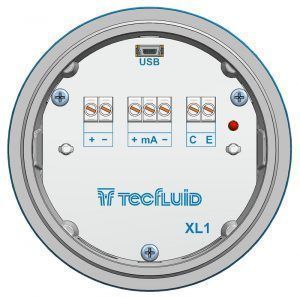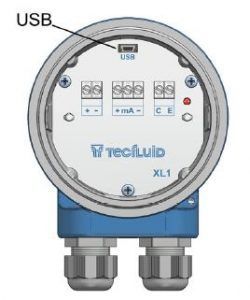We release the new XL1 converter for in-line or insertion electromagnetic flowmeters, which uses the most advanced technology based on digital signal processing to obtain accurate and reliable measurements.
The XL1 is a compact design converter for measuring the flow rate of conductive liquids and complements the series XT5 and MX4 of Tecfluid’s converters for electromagnetic flowmeters.
The FLOMID series of in-line electromagnetic flowmeters and the FLOMAT series of insertion ones with XL1 converter are based on Faraday’s induction law.
Working principle of in-line electromagnetic flowmeters
When an electrically conductive liquid flows through a magnetic field, perpendicular to the flow direction, it induces a voltage V proportional to the liquid velocity.
Two electrodes in contact with the liquid and positioned perpendicularly to the magnetic field, sense this voltage V, proportional to the average velocity vm of the liquid, which is captured by the XL1 converter to be processed and converted into a flow measurement.
V = B ・ vm ・ D
V = Measured voltage in the electrodes
B = Magnetic field
vm = Average liquid velocity
D = Pipe diameter

Working principle of in-line
electromagnetic flowmeters
Working principle of insertion electromagnetic flowmeters
When an electrically conductive liquid flows through a magnetic field, perpendicular to the flow direction, it induces a voltage V proportional to the liquid velocity.
Two electrodes in contact with the liquid and positioned perpendicularly to the magnetic field, sense this voltage V.
V = B ・ v ・ d
V = Measured voltage in the electrodes
B = Magnetic field
v = Liquid velocity
d = Distance between electrodes

Working principle of insertion
electromagnetic flowmeters
Main features of the XL1 converter

- Robust IP66/67 coated aluminium enclosure
- High mechanical resistance

The XL1 has two output types programmable by user:
- Analog output with 4-wire system proportional to the flow rate
- Configurable opto-isolated digital outputto provide volume information or alarm output
In this converter, the signal processing against ground / residual currents has been improved to provide a more stable reading.
This converter offers a greater accuracy when transmitting pulses with respect to volume. The output quality means that no pulses are lost and therefore no volume is lost, making the remote volume reading much more accurate.
The coil excitation by means of pulsed signal makes possible to obtain a negligible zero drift.
The XL1 converter is associated to Tecfluid electromagnetic flow sensors that can be manufactured with liners in different materials and with different process connections.
Programming of XL1 electronics
All the instrument parameters can be programmed via USB, with the software Winsmeter XL1 of Tecfluid S.A. that can be downloaded from the “Downloads” section of our website.
Its installation is as simple as to extract the two files contained in “Winsmeter XL1.zip”, execute the “Setup.exe” file and follow the indicated steps.
In order to connect the converter to a computer an USB cable is required. This cable is type A at one end and mini USB type B at the other, and it is readily found on the market.

Mini USB type B connector

Ends of required cable

Programming screen detail
The associated Winsmeter XL1 software allows programming and adjustment of the instrument in a comfortable and intuitive way.
Values for 4 mA and 20 mA and other parameters of the converter are programmed with this software.
It also has a Datalogger for data acquisition. In this window the evolution of the process of the different variables of the equipment can be registered. Time between samples, as well as the start and end time of the record can be configured, allowing to create a CSV format file which can be viewed directly with a spreadsheet and saved it on a computer:

New firmware updates can be downloaded from the Tecfluid website. These updates contain improvements or bug corrections that make the equipment to operate at best conditions.
Technical characteristics of the XL1 converter associated to FLOMID electromagnetic flowmeters
- Accuracy:
±0.5% reading value for v ≥ 0.4 m/s
± [0.2 / v (m/s)] % reading value for v ≤ 0.4 m/s
- Velocity range:
0.15 …10 m/s
- Temperature:
Process temperature:
PP: -10ºC … +80ºC
PTFE, PVDF: -20ºC … +120ºC
Ebonite: -20ºC … +90ºC
Ambient temperature: -20ºC … +70ºC
- Minimum conductivity:
20 μS/cm
- Power supply:
20 … 30 VDC
Power consumption: ≤ 5 W
- Analog output:
4 – 20 mA. Active or passive. Galvanically isolated from the power supply
4-wire system
- Pulse output:
Opto-isolated. NPN bipolar transistor.
Vmax: 30 VDC. Imax: 30 mA.
Frequency range: 0.01 Hz … 5000 Hz
Programmable duty cycle
Programmable as pulse output or as alarm (inverted flow, empty pipe or flow alarm) output
- Flow rate cut off, programmable
- Adaptative flow rate filter:
Integration time programmable between 1 and 25 seconds
- Zero offset adjustment
- Ingress protection:
IP65 (FLOMID-0XL)
IP66/IP67 (FLOMID-2XL, 4XL, XL1 converter)
Technical characteristics of the XL1 converter associated to FLOMAT electromagnetic flowmeters
- Accuracy:
±3.5% reading value for v ≥ 0.5 m/s
± [1.75 / v (m/s)] % reading value for v ≤ 0.5 m/s
- Velocity range:
0.15 …10 m/s
- Temperature:
Process temperature: -20ºC … +120ºC
Ambient temperature: -20ºC … +70ºC
- Minimum conductivity:
20 μS/cm
- Power supply:
20 … 30 VDC
Power consumption: ≤ 5 W
- Analog output:
4 – 20 mA. Active or passive. Galvanically isolated from the power supply
4-wire system
- Pulse output:
Opto-isolated. NPN bipolar transistor.
Vmax: 30 VDC. Imax: 30 mA.
Frequency range: 0.01 Hz … 5000 Hz
Programmable duty cycle
Programmable as pulse output or as alarm (inverted flow, empty pipe or flow alarm) output
- Flow rate cut off, programmable
- Adaptative flow rate filter:
Integration time programmable between 1 and 25 seconds
- Zero offset adjustment
- Ingress protection:
IP65 (FLOMAT-0XL)
IP66/IP67 (XL1 converter)
Some applications
This converter is especially indicated for:
- Applications of treatment and distribution of drinking water or wastewater where the measurement in several points of these systems allows the detection and reduction of possible leaks
- Applications in pharmaceutical industry
- Food and beverage industry
- Petrochemical industry
- Paper industry
- Automotive industry
- Process industry…

The XL1 converter is a new step of Tecfluid to provide solutions to flow measurement applications that we have in our daily lives.
Do you want us to inform you personally about this converter? Click here and we will contact you so that you can explain to us what your application and your needs are.





